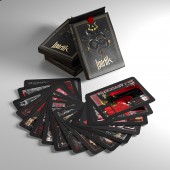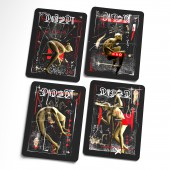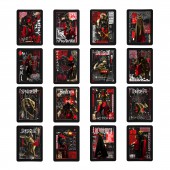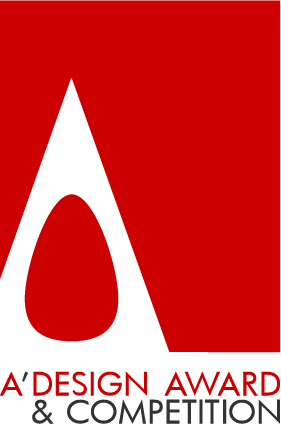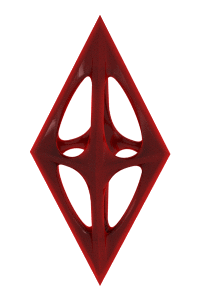
| THE AWARD |
| CATEGORIES |
| REGISTRATION |
| SUBMIT YOUR WORK |
| ENTRY INSTRUCTIONS |
| TERMS & CONDITIONS |
| PUBLICATIONS |
| DATES & FEES |
| METHODOLOGY |
| CONTACT |
| WINNERS |
| PRESS ROOM |
| GET INVOLVED |
| DESIGN PRIZE |
| DESIGN STORE |
| THE AWARD | JURY | CATEGORIES | REGISTRATION | PRESS | WINNERS | PUBLICATIONS | ENTRY INSTRUCTIONS |
Morok Social Deduction Game Cards by Egor Signienko |
Home > Winners > Design #117375 >Interview |
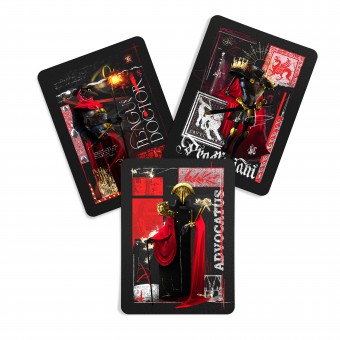 |
|
FS: What is the main principle, idea and inspiration behind your design?
ES: I have always strived to bring freshness to familiar formats. This game reflects my own passion for board games and my attempt to create something new, drawing inspiration from fantastic stories and imagery that have influenced me
FS: What has been your main focus in designing this work? Especially what did you want to achieve?
ES: I wanted to go beyond the ordinary, to look a bit into the future, and create a game that not only refreshes familiar gameplay but also becomes a collectible object, valuable both for players and for those who see art in everyday things
FS: What are your future plans for this award winning design?
ES: I still hope to launch production of this game, starting with small series that could become highlights at thematic events, comic cons, and exhibitions
FS: How long did it take you to design this particular concept?
ES: The development of the concept took about a year. I worked on it intermittently, giving myself time for reevaluation. I gradually developed the idea, created 3D objects, and experimented with graphics. I enjoy this pace as it allowed me to bring depth and a fresh perspective to the project
FS: Why did you design this particular concept? Was this design commissioned or did you decide to pursuit an inspiration?
ES: This design is my authorial project. I was both the initiator and the target audience. I wanted to create something unique, new, and interesting without being constrained by deadlines. It was a way to realize my ideas without boundaries
FS: Is your design being produced or used by another company, or do you plan to sell or lease the production rights or do you intent to produce your work yourself?
ES: Currently, only a few prototypes have been created for testing. I wanted to produce the game myself, but currently I don't have the opportunity to do this. If someone expressed interest in producing this game, I would be open to discussing such a proposal
FS: What made you design this particular type of work?
ES: Many factors aligned to inspire this project: my love for the game, the boom in collectibles and NFTs, inspiring contemporary artists, and science fiction books I was reading at the time. This mix gave rise to the project.
FS: Where there any other designs and/or designers that helped the influence the design of your work?
ES: I can never say that any particular person influenced me. Influence always comes from within. I think certain styles and images settle in the mind and find their way into my work. I can’t always pinpoint specific sources
FS: Who is the target customer for his design?
ES: The target audience is people aged 16 and older who enjoy spending time with friends over board games or visiting gaming clubs. In my city, there are even bars that hold Werewolf game sessions a couple of times a year
FS: What sets this design apart from other similar or resembling concepts?
ES: Its uniqueness lies in the approach. This design stands out with its distinct visual style, limited edition, and overall aesthetic.
FS: How did you come up with the name for this design? What does it mean?
ES: For the name, I wanted something unique that sounds eerie and enveloping, like fog in horror films, while incorporating something from my culture and language. "Morok" is an Old Slavic word that is no longer in use, meaning "Darkness" or "Gloom
FS: Which design tools did you use when you were working on this project?
ES: I created the 3D models in 3ds Max. For lettering, I used pens and gold or white paint on black cardboard, as well as gold leaf. These were scanned and assembled in Photoshop. Alongside software, I used numerous pens, knives, and improvised tools to achieve the desired effects. I also partially scanned fresco images from art history books I had left from my studies in architecture school
FS: What is the most unique aspect of your design?
ES: The most unique aspect is its eclecticism—everything from the choice of characters to the materials used. Nowadays, few people spend time using brushes and pens in graphic design when they can simulate them digitally. This, however, gives my work its distinct and unique appearance.
FS: Who did you collaborate with for this design? Did you work with people with technical / specialized skills?
ES: This project was done independently. My experience working in printing houses helped a lot. I know almost all image application techniques—from regular printing to silkscreen printing and various types of post-printing processing.
FS: What is the role of technology in this particular design?
ES: It’s hard to imagine creating such a project in such a short time or having the ability to replicate it without technology. Technology enabled me to create 3D graphics, digitize drawings, and experiment with object composition.
FS: Is your design influenced by data or analytical research in any way? What kind of research did you conduct for making this design?
ES: Yes, of course. Research directly influenced the depiction and roles of characters on the cards, as well as the fonts and overall style of the game. Books on architecture and art history were particularly helpful, as they provided examples of daily life, frescoes, and scripts
FS: What are some of the challenges you faced during the design/realization of your concept?
ES: When working with new tools, you never know how they will behave or what results you’ll get. Especially with physical tools, where you can’t undo an action or save a particular iteration. This randomness, however, adds liveliness and realism to the work.
FS: How did you decide to submit your design to an international design competition?
ES: Initially, I didn’t plan to submit this work, and it was still in its early stages when I made the decision. It all started with an email invitation to submit my branding project for a consulting agency. I didn’t think that project was very competitive, but the idea of participating inspired me. So, I sped up the development of "Morok" to submit it for the award.
FS: What did you learn or how did you improve yourself during the designing of this work?
ES: I did a lot of work and discovered many new things. I improved my 3D skills and experimented with various graphic techniques. Most importantly, I felt responsible for my project when I decided to enter the competition. Participation required completing extensive supporting documentation, which helped me better understand myself, my work, and its impact on design as a whole.
FS: Any other things you would like to cover that have not been covered in these questions?
ES: This project is my personal reflection on the intersection of technology and art, and I am glad I was able to bring my idea to life
FS: Thank you for providing us with this opportunity to interview you.
A' Design Award and Competitions grants rights to press members and bloggers to use parts of this interview. This interview is provided as it is; DesignPRWire and A' Design Award and Competitions cannot be held responsible for the answers given by participating designers.
| SOCIAL |
| + Add to Likes / Favorites | Send to My Email | Comment | View Press-Release |


